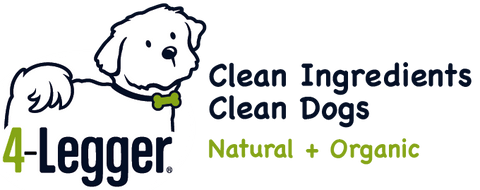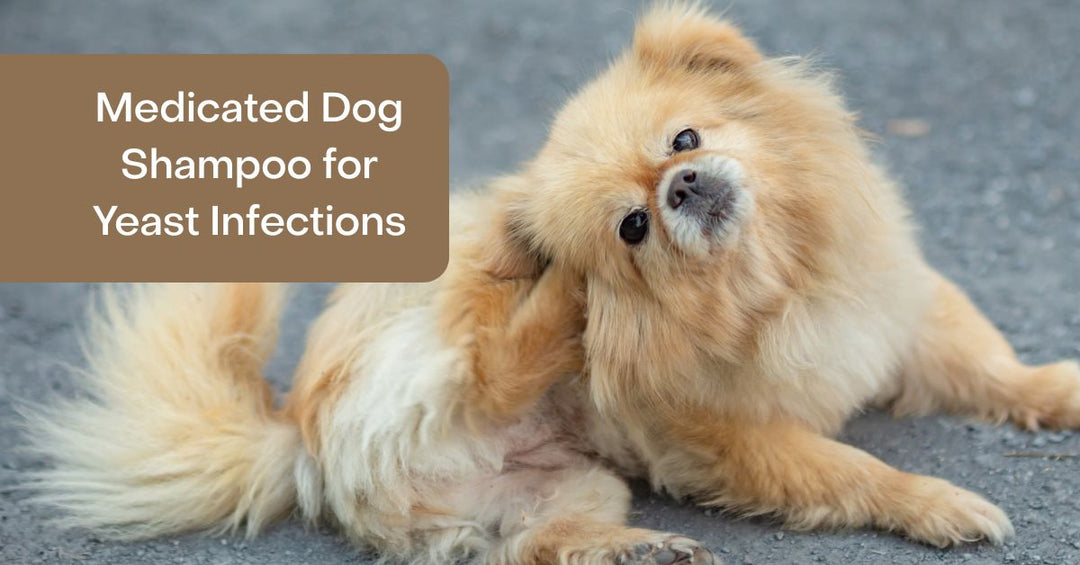What is Antifungal Dog Shampoo? Are There Safe Yeast Dog Shampoo Alternatives?
The majority of the antifungal dog shampoo products on the market contain Chlorhexidine gluconate.
Chlorhexidine or CHG is a very effective antiseptic and disinfectant that is known to have broad-spectrum activity against gram-positive and gram-negative bacteria, yeast, and some lipid-enveloped viruses. It works by weakening the cell membrane.
When used orally1, chlorhexidine has been shown to kill nearly 100% of Gram-positive and Gram-negative bacteria within 30 seconds; so, when used on skin you would expect it to be equally as effective.
This effectiveness may actually be a problem.
Your dog's skin microbiome - the mix of beneficial bacteria, yeasts and parasites (including beneficial mites) that live on your dog's skin, in their nose, trachea, and gut all have links to autoimmune health.
The use of probiotics in dogs has soared in recent years as we try to re-establish the natural health of our dog's guts (a topic for another day).
Scientists believe the skin microbiome helps maintain healthy skin and has a link to metabolic functions. If properly tended, the microbiome can help to regulate the skin's health. When the microbiome is out of balance, too many free radicals emerge, inflammation increases, and the dog's body chemistry falters, leading to allergies, itchy skin, and poor health.
One study demonstrated that the skin of healthy dogs has a much higher diversity and population of microbial cultures than that of dogs with skin allergies.2
Recent (June 2017) research looked at the skin microbiome in the nose of cats and nasal disease which they hypothesized that the lower population diversity of the microbiome may be in some way linked to nasal disease.3
What Does Skin Microbiome Have To Do With Chlorhexidine Dog Shampoo?
While chlorhexidine is effective at killing bacteria, it is not an antibiotic as antibiotics target specific classes of bacteria. Despite that distinction, you may see it marketed as an antibacterial dog shampoo.
Chlorhexidine has been used in the medical community for over 60 years as a pre-surgical skin wipe and more recently to coat medical implants.
In the use of veterinary or human surgery, one can see the clear benefits for using an antiseptic since preventing infection is of the utmost importance.
What Does the FDA Say About Chlorhexidine Dog Shampoo?
- The FDA's website says that dog shampoos fall under a category called "animal grooming aids" - the animal counterpart of a cosmetic. These products are not subject to FDA approval unless they contain a drug or have a therapeutic purpose.
- The FDA confirmed in an email inquiry that chlorhexidine is considered an over the counter drug.
- The FDA confirmed in the same email inquiry that there are no FDA approved dog shampoos that contain chlorhexidine.
- Dog shampoos that contain Chlorohexidine should have a drug panel with all of the ingredients listed, warnings, and other information.
- These dog shampoo with chlorhexidine are supposed to be marketed as unapproved animal drugs.
This is what the FDA says about unapproved animal drugs:
"Unapproved animal drugs are new animal drugs that don’t have legal marketing status. They have not been approved, conditionally approved, or indexed by FDA. Unapproved animal drugs may not meet the agency’s strict standards for safety and effectiveness and may not be properly manufactured or properly labeled."
The Over Use of Chlorhexidine Dog Shampoo
As you can probably guess, there are no studies that look specifically at the safety of anti-fungal dog shampoo.
If we analyzed data from Amazon.com we found literally hundreds of dog shampoos that contain chlorhexidine.
If we study just the first 50 (top sellers) of the chlorhexidine dog shampoos that come up in an Amazon search we have some interesting data:
Amazon's 50 top selling Chlorhexidine dog shampoos sell an average of $800,000 a month with an average sale price of $25.50 per bottle (based Amazon's data for 15 January - 15 February 2018. These sales dramatically increase during the warm months).
That is a LOT of fungal dog shampoo!
We also noticed that not all of the chlorhexidine dog shampoos had a "Drug Panel" on the bottle as required by the FDA. The drug panel requires a company to disclose the ingredients.
We were only able to find the full list of ingredients for 17 of the 50 (34%) fungal dog shampoo products after visiting the manufacturer's websites if the ingredients weren't listed on Amazon.com.
Keeping in mind that many of these products claimed to contain "all natural ingredients that are safe for you and your pets", even we were surprised at some of the ingredients we found in these products:
| Ingredient Listed | Our Rating of This Ingredient | Synthetic or Natural? |
Safety of This Ingredient |
| Propyl Paraben (Propylparaben) |  |
 |
Paraben mimics estrogen and can act as a potential hormone (endocrine) disruptor |
| Methylparaben |

|

|
Paraben mimics estrogen and can act as a potential hormone (endocrine) disruptor. Some concerns for biochemical or cellular level changes. |
| Triethanolamine |

|

|
Concerns from nitrosamine contamination (links to cancer) and organ system toxicity links. |
| Lauramide DEA |

|

|
Concerns from nitrosamine contamination (links to cancer) and organ system toxicity links. |
| Imidazolidinyl Urea |

|

|
Formaldehyde releasing preservative. Dogs exposed to this ingredient may develop a formaldehyde allergy. |
| Cosmetic grade preservative |

|

|
While we don't know what these ingredients are, they are likely one of the other ingredients listed above or below on this same list. |
| Methylisothiazolinone |

|

|
Known skin irritant to the skin with links to neurotoxicity and allergic reactions. |
| Polyquaterinium- 7 |

|

|
Contamination concerns from acrylamide (carcinogen) with links to organ system toxicity and ecotoxicology. |
| Methylchloroisothiazolinone |

|

|
A known skin irritant with links to allergic reactions. |
| DMDH hydantoin |

|

|
A formaldehyde releasing preservative with links to skin irritation. |
| Artificial fragrance |

|

|
Links to cancer and organ system toxicities. |
| Chlorhexidine |

|

|
Known links to skin irritation. |
None of these 50 products we researched would be considered a true natural dog shampoo since they all contained synthetic ingredients.
Further, they all contained ingredients that pose long term health risks.
Oh, I know. Your eyes have glazed over and all you really want to know is the simple answer to this question:
Is chlorhexidine dog shampoo safe to use on my dog?
Yes and no. If your dog is having surgery, using chlorhexidine as an infection prevention on the surgical area is a valid surgical protocol.
As a general use shampoo, no. If you care about your dog's long term health, the use of chlorhexidine dog shampoo is not worth the benefits when there are safer all natural alternatives available.
What you need is a gentler dog shampoo that will clean without eradicating the microbiome on your dog's skin.
Our recommendation would be using 4-Legger's safe and non-toxic unscented organic aloe dog shampoo with YeastyBeasty™ - an essential oil blend formulated by integrative and holistic veterinarian Dr. Melissa Shelton.
Essential oils help to restore balance - they will help to clear the unhealthy yeast, bacteria, and fungus without completely destroying the microbiome.
YeastyBeasty™ essential oil blend naturally supports a stronger immune system and the clearance of yeast, bacteria, and fungus. The formulation is based on clinical data from Dr. Shelton's use in her veterinary practice. Yes! The use of essential oils based on science! We love it!!!
Ingredients in YeastyBeasty™
Essential Oils of Lavender (Lavandula angustifolia), Rosemary Verbenone Chemotype (Rosmarinus officinalis), Helichrysum (H. italicum), Lemongrass (Cymbopogon flexuosus), Geranium (Pelargonium graveolens), Oregano (Origanum vulgare), Thyme (Thymus vulgaris), Tea Tree (Melaleuca alternifolia), Myrrh (Commiphora myrrha), Copaiba (Copaifera officinalis), Frankincense (Boswellia carterii), Clove (Eugenia caryophyllata), Cypress (Cupressus sempervirens), Basil (Ocimum basilicum), Lemon (Citrus limonum), Black Spruce (Picea mariana), Peppermint (Mentha piperita), Melissa (Melissa officinalis), Cinnamon Leaf (Cinnamomum zeylanica)
General Safety of Chlorhexidine
As background we read a number of studies that looked at the safety of chlorhexidine. We are including them below for your own information.
- "Be very careful when using chlorhexidine topical on a child younger than 2 months old. This medicine may cause severe irritation or chemical burns on a very young child." (4)
- The U.S. Food and Drug Administration (FDA) is warning that rare but serious allergic reactions have been reported with the widely used skin antiseptic products containing chlorhexidine gluconate. Although rare, the number of reports of serious allergic reactions to these products has increased over the last several years (5)
- CHG is absorbed into the bloodstream when used topically, but it is unknown what long term implications this may have as more data are needed to further explore skin toxicity and CHG absorption through the skin into the bloodstream (6)
- There are no established values for what is considered to be a safe concentration of CHG in the blood (6)
- One study investigating the toxicity of certain antiseptics when placed on human skin substitute reported moderate cytotoxic effects from chlorhexidine
References:
1 - Genuit, Thomas, Grant Bochicchio, Lena M. Napolitano, Robert J. McCarter and Mary-Claire Roghman. "Prophylactic Chlorhexidine Oral Rinse Decreases Ventilator-Associated Pneumonia in Surgical ICU Patients."Surgical Infections March 2001, 2(1): 5-18. doi:10.1089/109629601750185316.
2 - Rodrigues Hoffmann A1, Patterson AP2, Diesel A2, Lawhon SD3, Ly HJ1, Elkins Stephenson C4, Mansell J1, Steiner JM4, Dowd SE5, Olivry T6, Suchodolski JS4. The skin microbiome in healthy and allergic dogs. PLoS One. 2014 Jan 8;9(1):e83197. doi: 10.1371/journal. eCollection 2014.
3 - Dorn ES1, Tress B1, Suchodolski JS2, Nisar T2, Ravindran P2, Weber K1, Hartmann K1, Schulz BS1. Bacterial microbiome in the nose of healthy cats and in cats with nasal disease.PLoS One. 2017 Jun 29;12(6):e0180299. doi: 10.1371/journal. eCollection 2017.
4 - C.S. Mott Children's Hospital. University of Michigan Health Library. http://www.mottchildren.org/health-library/d01231t1
5 - https://www.fda.gov/Drugs/DrugSafety/ucm530975.htm
6 - A.K. Chapman, S.W. Aucott, A.M. Milstone. Safety of chlorhexidine gluconate used for skin antisepsis in the preterm infant. Journal of Perinatology. 2012. V 32: 4–9.





